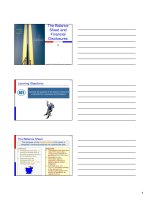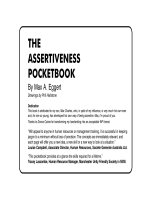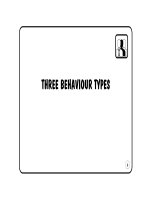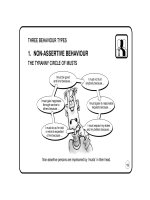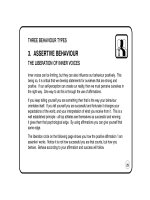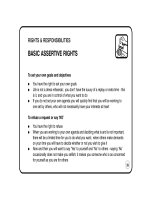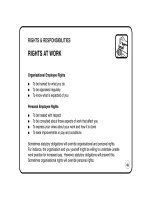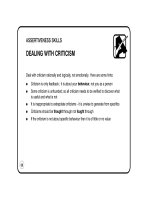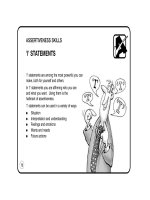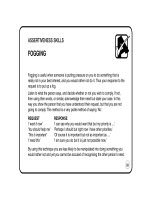THE BALANCE SHEET POCKET BOOK phần 6 pptx
Bạn đang xem bản rút gọn của tài liệu. Xem và tải ngay bản đầy đủ của tài liệu tại đây (96.48 KB, 12 trang )
£
THE BALANCE SHEET
VALUATION OF WORKING CAPITAL
The values shown in the Balance Sheet are as follows:
Stock At the lower of cost and net realisable (ie: saleable) value
- Allowances are made for slow-moving
and redundant stock, etc
Debtors At the sum expected to be collected
- Bad debts are written off
- Allowances are made for possible bad debts
Cash At face value
Creditors At the sum expected to be paid
52
THE BALANCE SHEET
SOURCE OF FUNDS
VALUATION
We now reach the bottom half of the Balance Sheet, which shows where the funds
(used in the top half) came from.
● SHARE CAPITAL
the number of shares issued valued at
a standard or ‘nominal’ value (see page 54)
● LOAN CAPITAL
long-term borrowings from Banks
(or similar institutions)
● RETAINED PROFITS
the accumulation of profits re-invested
into the business, reported on the
Balance Sheet under the collective term
‘Reserves’ (see page 54)
53
SOURCE
OF
FUNDS
SHARE CAPITAL
LOAN CAPITAL
RETAINED PROFITS
THE BALANCE SHEET
RESERVES
‘Reserves’ is a collective term used on the Balance Sheet and forms part of the
shareholders’ investment in the business.
The principal reserves are:
Retained Profits:
This represents the cumulative profits made by the business which have been
‘ploughed back’. p16
Share Premium Account:
Share Capital is shown on the Balance Sheet at its ‘Nominal Value’, eg: £1 per share.
If shares are issued above nominal value the premiums are put into the
Share Premium Account.
Example: Company X has shares with a nominal value of £1. The company issues
100,000 new shares at the current market price of £1.30.
Share Capital increases by £100,000
Share Premium Account increases by £30,000
balanced by the increase in Cash of £130,000.
54
THE BALANCE SHEET
RESERVES
Revaluation Reserve:
Companies are required periodically to revalue their Land and Buildings and adjust
their Balance Sheet values accordingly.
● The business belongs to the shareholders
● Therefore any change in the value of assets held by the business falls to
those shareholders
● Hence any increases or decreases in asset values caused by revaluation will be
matched by an increase or decrease in the Revaluation Reserve
Note: Depreciation of Buildings will be based on the revalued amount.
55
THE BALANCE SHEET
THE BALANCING ACT
● You can’t do something with money you never had
● Neither can money you have had just disappear!
56
✗
✗
THE BALANCE SHEET
COMMON MISCONCEPTIONS
‘The accountant balances the Balance Sheet by entering a balancing figure
somewhere probably profit.’
The Balance Sheet balances automatically because for every transaction in the books
of account there are always two entries - double-entry book-keeping!
The two entries will either increase or decrease both halves of the Balance Sheet by the
same amount, or there will be equal plus and minus entries within the same half.
See the following examples.
57
THE BALANCE SHEET
COMMON MISCONCEPTIONS
EXAMPLES
Source of Funds Use of Funds
Issue £1m shares
(at nominal value) for cash + £1m Share Capital + £1m Cash
Repay £0.5m Loan Capital - £0.5m Loan Capital - £0.5m Cash
Purchase new
machine for £50k cash + £50k Fixed Asset - £50k Cash
Remember: the Balance Sheet must balance because the two halves are explaining:
Source of Funds - where the money came from
Use of Funds - where it is now
58
THE BALANCE SHEET
ARC plc
THE
BALANCE
SHEET
59
THE BALANCE SHEET
SUMMARY
This is a summarised Balance Sheet for ARC plc:
60
Balance Sheet as at 31st December 200-
Note £`000 £`000
USE OF FUNDS
Fixed Assets 470
Current Assets 520
Less:
Current Liabilities 290
Working Capital 2 230
Net Assets Employed 1 700
SOURCE OF FUNDS
Issued Share Capital 300
Reserves 3 200
Shareholders’ Funds 4 500
Loan Capital
Net Capital Employed 1 200
700
THE BALANCE SHEET
SUMMARY
Notes:
1 Net Assets Employed is the accountant’s term for the total Use of Funds
Net Capital Employed is the accountant’s term for the total Source of Funds
Hence:
Net Assets Employed = Net Capital Employed p56
2 Working Capital = Current Assets - Current Liabilities p51
3 Reserves is a collective term which includes
Retained Profits accumulated over the life of the business p54
4 Shareholders Funds (or Net Worth) is the total amount of long-term funding
invested by the shareholders either directly (by buying shares) or indirectly
(by allowing some of their earnings to be re-invested as Retained Profits)
61
THE BALANCE SHEET
SUMMARY
Here is the same Balance Sheet expanded to itemise the Fixed Assets
and the constituent parts of Working Capital:
Balance Sheet as at 31st December 200-
£’000 £’000 £’000
Fixed Assets
Land & Buildings 230
Plant & Equipment 170
Vehicles 70 470
Current Assets
Stock 320
Debtors 190
Cash 10
Less:
Current Liabilities 520
Creditors 290
290
Working Capital 230
Net Assets Employed 700
Source of Funds
Issued Share Capital
300,000 £1 Ordinary Shares 300
Reserves
Retained Profits 200
Shareholders Funds 500
Loan Capital 200
Net Capital Employed 700
62
THE BALANCE SHEET
SUMMARY
Be careful! This statement has its limitations!
Remember that the Balance Sheet is a snapshot,
at a point in time, of where the money came
from and how it is currently invested.
What do people do before having their
photographs taken? They make themselves
look as presentable as possible.
Companies do the same thing!
The camera may not lie but
just what does that business look like
for the other 364 days of the year?
Chaotic? - perhaps!
63
